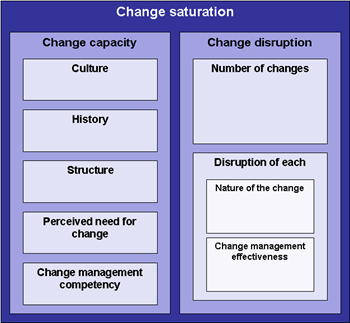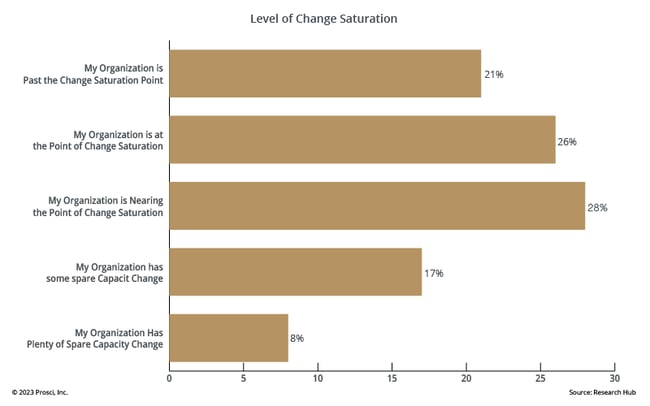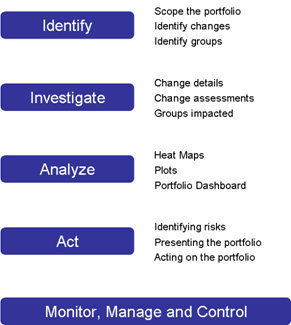Enough is Enough: Tips for Avoiding Change Saturation

5 Mins
Updated: March 28, 2025
Published: March 17, 2015

One of the biggest obstacles facing change management professionals and project leaders is the threat of too much change. We call this change saturation, and overcoming it requires a focused approach.
What Is Change Saturation?
Change saturation occurs when there is so much change going on that it negatively impacts individuals and the organization. This typically occurs because no one in the organization keeps a "portfolio" view of all the change efforts underway. When a project team focuses exclusively on their particular business opportunity or challenge, they do not see how their change effort collides with other changes underway.
Although Project Management Offices (PMOs) are making headway in project portfolio management, the work here is typically limited to inventorying projects and their associated technical details. They fail to create the necessary portfolio view of the collective or cumulative impact of all the changes. Given the ever-increasing amount of change in organizations—including frequency, size and breadth of impact—they are often faced with too much change.
More Disruption Than Capacity
Change saturation is a function of two variables: change capacity and change disruption. It is a function a supply and demand. How much change can a group or organization handle versus how much change is currently happening. Consider a bucket of water. The size of the bucket represents change capacity, while the amount of water in the bucket (and being added to the bucket) represents change disruption. When change disruption is greater than change capacity, an organization faces change saturation.
The Prosci Change Saturation Model breaks down change capacity and change disruption, the components that drive change saturation.
Prosci Change Saturation Model

Change capacity is a function of culture, history, structure, perceived need for change, and change management competency. Change disruption is a function of the number of changes going on and the disruption that each one causes. The disruption a change effort creates (or the amount of water the effort adds to the bucket) is determined by the nature of the given initiative and how effectively the people side of the change is managed.
Organizations are saturated with change
Many organizations are feeling saturated right now. In addition to pandemic-related changes, industries are changing, the economy is uncertain, and many companies are facing growing pressure to change in order to survive.
Prosci's Best Practices in Change Management research has benchmarked saturation in organizations since 2007. In the most recent study, 73% of respondents reported being near, at or past the point of saturation.

Tactics for Neutralizing Change Saturation
Change saturation impacts how organizations operate. Is your organization feeling the strain of change saturation? Try these tactics to neutralize change saturation.
Raise awareness about the consequences
Change saturation has consequences. It cannot be ignored. Consequences of saturation include individual behaviors, impacts on projects, and implications for the organization as a whole.
Individuals
Ultimately, it is individuals in the organization who feel change saturation. They are tasked with completing their own work and adopting new changes to how their work is done. When there is too much change happening, individuals react. Individual behaviors resulting from saturation include disengagement and apathy, frustration and increased stress, fatigue and burnout, more resistance to change, confusion, cynicism, and skepticism.
Projects
In times of change saturation, projects do not get the budget, human resources and mindshare they need. The result is that projects do not meet objectives and fail to deliver the intended results for the organization. Impacts on projects in a change-saturated environment include unrealized benefits, lack of resources, unsustained changes, and projects that fail to gain momentum.
Organization
In addition to the individual and project impacts, the organization as a whole can suffer. Consequences of change saturation for the organization include higher turnover, productivity declines, increased absenteeism, loss of focus on business basics, and low morale.
Across the board, there are costly consequences of having too much change in the organization. The first step in combating change saturation is building an awareness and appreciation of these consequences by showing senior leaders the risks of not managing the portfolio of change.
Map your current portfolio of change
Managing the portfolio of change requires evaluating collective change efforts and cumulative impacts those impacts are having. Rarely someone take a step back during change and do this. Senior leaders know what initiatives they have invested in, but they do not see how those change efforts impact employees. Project teams focus on delivering the best solution they can for the opportunity or issue at hand, but they do not see how their work interacts with other change efforts. Front-line employees and managers are often the ones who feel the brunt of change saturation, but they rarely have any recourse.
Organizations must take seriously the entire portfolio of change impacting employees and workgroups. Although there has been progress in "project" portfolio management, this work is typically limited to inventorying the technical details of the formal projects impacting an organization. Prosci has developed a Change Portfolio Management Process to help organizations and leaders better understand, evaluate and manage the portfolio of change. 
Phase 1: Identify
In this initial phase, we establish the boundaries of the analysis. An inventory of the change efforts underway is created, including both formal projects and non-project changes. The different groups in the organization are segmented to enable change impact to be evaluated in the next step.
Phase 2: Investigate
This phase is dedicated to learning about each of the change efforts in the portfolio. A common set of data is collected about each change including the size, impact, disruptive nature, risks and health of the initiative. This is also where the mapping of each change to the groups impacted by that change occurs.
Phase 3: Analyze
In the third phase, a portfolio perspective is created. Heat maps are graphical depictions of who a change impacts. The cumulative impact of all the changes in the portfolio drives an organizational heat map, which shows areas of change saturation. Various other graphs are created to show the positioning of the current portfolio. Finally, a creating a portfolio dashboard enables capturing of high-level data and risks for the portfolio.
Phase 4: Act
In the Act phase, the portfolio moves from an academic to a pragmatic tool. Risks are identified for specific change efforts, groups in the organization, and points-in-time where there is too much disruption occurring. The portfolio is presented to senior leaders and others in the organization who will benefit from a big picture of the current change environment. Actions are taken to alleviate change saturation and the consequences of changes colliding.
Phase 5: Monitor, Manage and Control
The final step of the Change Portfolio Management Process is where the portfolio becomes a management tool for evaluating new change efforts being proposed and change efforts that are concluding.
Manage your changing portfolio
The portfolio of change is not static. It is constantly changing as a result of new change efforts being introduced and old change efforts being retired. To manage the portfolio of change requires attention to efforts entering or exiting the portfolio. With a portfolio management system in place, new changes can be evaluated based on the impact they will have on the entire portfolio. When changes exit the portfolio, you can evaluate the impact of the change and learn lessons that can be applied to upcoming efforts. The change portfolio system closes the loop.
Apply Effective Change Management
A final note about the role change management plays in addressing change saturation. In the Prosci Change Saturation Model, there are two characteristics of a given change effort that determine how much capacity it consumes. The first is the nature of the change, and in most instances you cannot impact the size or type of changes required by the effort. However, the second factor is how effectively the people side of change is managed.
If an initiative is introduced with no change management, it can be extraordinarily disruptive. People will constantly ask why the change is happening in the first place. There will be more resistance to change and greater instances of people dragging their feet or fully opting out of the prescribed change. This is very disruptive and can consume large amounts of the capacity for change.
However, effective and proactive change management can greatly reduce the disruption of the initiative. Senior leaders are engaged, and actively and visibly support the effort. Communication plans are developed early in the process and targeted for particular audiences with the right messages. People managers are prepared to coach their employees and perform their critical roles in change. And resistance is anticipated and addressed before it impacts the effort. You can help address change saturation when you apply a structured approach to managing the people side of change. 
![]()


